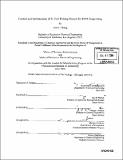Control and optimization of E. coli picking process for DNA sequencing
Author(s)
Chang, Julia L., 1975-
DownloadFull printable version (2.761Mb)
Alternative title
Control and optimization of Escherichia coli picking process for deoxyribonucleic acid sequencing
Other Contributors
Leaders for Manufacturing Program.
Advisor
Roy E. Welsch and Gregory J. McRae.
Terms of use
Metadata
Show full item recordAbstract
As part of its responsibility to the National Institutes for Health, the sequencing operation at the Broad Institute strives for cost-effective production. This thesis attempts to reduce variability in the sequencing operation's E. coli colony picking process-thereby improving efficiency-through the application of traditional operations improvement methodology. To achieve control over variability, the author first seeks to characterize the variability and identify its drivers, then to reduce the variability by manipulating the drivers, and finally to optimize productivity. The operations techniques utilized include fishbone cause-and-effect diagram, process flow diagram and organizational analysis. Several industrial statistical techniques such as control charting, linear regression, analysis of variance and designed experimentation are also heavily employed. Many factors were studied as candidate drivers of variability. Three criteria are used to discriminate among them: statistical significance, magnitude of effect on variability and controllability. The results show that one of the largest but least controllable factors is plate density, i.e., the number of colonies on a plate. Instead of attempting to control individual confounding factors in plate preparation, this thesis presents an alternative strategy for overcoming the plate density variability: introduction of a novel spotting process that allows for plate variability but still yields higher efficiency.
Description
Thesis (M.B.A.)--Massachusetts Institute of Technology, Sloan School of Management; and, (S.M.)--Massachusetts Institute of Technology, Dept. of Chemical Engineering; in conjunction with the Leaders for Manufacturing Program at MIT, 2004. Includes bibliographical references (p. 68).
Date issued
2004Department
Leaders for Manufacturing Program at MIT; Massachusetts Institute of Technology. Department of Chemical Engineering; Sloan School of ManagementPublisher
Massachusetts Institute of Technology
Keywords
Sloan School of Management., Chemical Engineering., Leaders for Manufacturing Program.